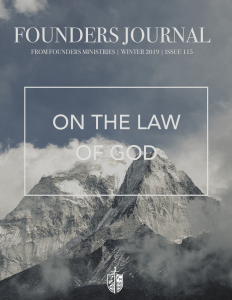I. INTRODUCTION
As Carl Trueman has recently reminded us,1 mere tacit affirmation of the words of confessions does not a confessional Christian make.2 The historic doctrinal formulations are, by nature, dogmatic assertions, a topical summary of Scriptural truth.3 Therefore, the meaning of the words therein must be affirmed and believed and said meaning must be understood within the historic context in which they were first employed. The words of the historic confessions were intentionally and carefully chosen because they already possessed precise and established meaning. Therefore, “They are not empty placeholders onto which the reader can impose any meaning he chooses,” says Trueman. If the opposite were the case then the purpose of confessions, namely, to guard the deposit of truth (2 Timothy 2:14), would be undermined. A reader-response style confessionalism guards nothing except the immediate, subjective sentiments of the individual reader.
It is essential to understand the imported meaning of confessional terms, the original intent of the authors, so that Christians can honestly subscribe to them with the same intentionality and care with which they were formulated. This is what it means to be truly confessional.
Accordingly, this article endeavors to expound on the meaning of chapter 19 of the Second London Baptist Confession of Faith (SLC), specifically its use of “the light of nature” or “law of nature,” otherwise known as the natural law, as understood in the seventeenth-century context. As will be shown, the particular use of natural law concepts and terms in the SLC situates the seventeenth-century English Baptist codifiers squarely within the broader Reformed consensus at the time.
II. CHAPTER 19: OF THE LAW OF GOD
Perhaps it goes without saying that before we can discern the meaning of chapter 19 of the SLC regarding the natural law, we must first outline what the text says.4 Chapter 19 opens as follows:
God gave to Adam a law of universal obedience written in his heart, and a particular precept of not eating the fruit of the tree of knowledge of good and evil; by which he bound him and all his posterity to personal, entire, exact, and perpetual obedience; promised life upon the fulfilling, and threatened death upon the breach of it, and endued him with power and ability to keep it.5
The reference to the “law of universal obedience written in [Adam’s] heart” refers the reader back to chapter 4 (“Of Creation”) of the confession. Article 2 therein states that God made Adam and Eve with “responsible and immortal souls” which were capable of living unto God. They were supplied with innate knowledge of God’s moral law by His inscribing of it upon their hearts and they had power to fulfill it without the aid of supernatural grace.6 Besides this natural knowledge of the moral law, God also gave man a positive precept, namely, the “command not to eat of the tree of knowledge of good and evil, which whilst they kept, they were happy in their communion with God.”7 This combination of law, stipulation, and promise spoken of in chapter 4 has been referred to by Reformed authors as the creative or natural covenant, or more commonly, the covenant of works.8
Chapter 19.2 then affirms that the same moral law that was written on the hearts of Adam and Eve continues “to be a perfect rule of righteousness after the fall, and was delivered by God upon Mount Sinai, in ten commandments, and written in two tables, the four first containing our duty towards God, and the other six, our duty to man.”9
Doubling down on the continued veracity and applicability of this law, the confession reiterates in 19.5 that “The moral law doth forever bind all, as well justified persons as others, to the obedience thereof, and that not only in regard of the matter contained in it, but also in respect of the authority of God the Creator, who gave it; neither doth Christ in the Gospel any way dissolve, but much strengthen this obligation.”10 In short, the moral law, though not the positive precept regarding the tree of knowledge, endured after the fall of man. It is eternally binding on all men and not abrogated by the gospel, but on the contrary, does “sweetly comply with it.”
To the latter point, 19.7 clarifies that in true believers the Spirit of Christ subdues and enables the will of man to perform the law “freely and cheerfully.”11 Yet, 19.6 is quick to clarify that the performance of the moral law is not salvific. But God’s law “is of great use to them as well as to others, in that as a rule of life, informing them of the will of God and their duty, it directs and binds them to walk accordingly.” The moral law also has the effect of exposing sin, bringing men to conviction and repentance, showing them their need for Christ, and restraining sin.12
The 19th chapter also acknowledges that in addition to the moral law implanted in the hearts of all men, God prescribed other positive laws to the people of Israel which included ceremonial and judicial laws that were particular to their polity and context. These have been abrogated by the new covenant in Christ, yet, especially the judicial laws remain morally relevant and applicable today in terms of the general equity they convey.13
Like any document, the confession assumes at chapter 19 that the reader is acquainted with the preceding content.14 Better to understand the references made in chapter 19 to the moral law of God naturally known to man, it must also be remembered that the confession makes reference to such natural knowledge in its very first lines. In Chapter 1.1, establishing the principium cognoscendi externum of Scripture, the confession states that though not sufficient for saving knowledge of Christ,15 man can know by “the light of nature” and a studious examination of the created order “the goodness, wisdom, and power of God,” such that he is utterly left without excuse.16
From the above outline several observations can be made regarding the natural law. First, its divine authorship. The natural law is a product of God, just like His divine positive precepts in Scripture. Second, its promulgation. The natural law was implanted by God in man’s heart at creation and enjoys close connection to the imago Dei in humans. Third, its enduring relevance and universal applicability. The natural law, being connected to the imago Dei, continues to be present in, and binding on, all men after the fall. It was reiterated in the ten commandments (19.2) and was not abrogated by the gospel (19.5).
Having gathered the basic terms and summarized the general assertions of the confession regarding the natural law, the meaning of these terms and assertions must be set in their original intellectual context. In so doing, not only will the meaning of the text be illuminated, but it will become evident that the SLC was in full agreement with the Reformed consensus regarding the natural law.
III. NATURAL LAW IN SEVENTEENTH-CENTURY REFORMED ORTHODOXY
As Stephen J. Grabill surmises, since the at least twentieth-century “a cloud of suspicion and hostility has engulfed” the natural law in Protestant circles. This phenomenon was epitomized by the 1934 debate between Emil Brunner and Karl Barth.17 Several factors contributed to this shift, but such analysis is out of scope here. What is important to realize is that such was not always the case. In the period of High Orthodoxy (1620–1700),18 the natural law was a thoroughgoing element of Reformed theology.19 And this was no innovation of the seventeenth-century by which the Calvinists turned against Calvin and regressed to medieval scholasticism.20 Indeed, as John T. McNeil famously declared over seventy years ago, “There is no real discontinuity between the teaching of the Reformers and that of the predecessors with respect to natural law. Not one of the leaders of the Reformation assails the principle.”21 The natural law was part of the mental framework, a basic assumption, of the magisterial Reformers, and it continued to be so with their progeny. David VanDrunen has rightly observed that, “Natural law remains a fixture of the Reformed confessional heritage.”22
Richard Muller offers a helpful definitional summary of natural law as it stood in the era of High Orthodoxy. Each element of the following definition is present in the SLC. The natural law (lex naturalis or jus naturale) is,
[T]he universal moral law either impressed by God upon the mind of all people or immediately discerned by the reason in its encounter with the order of nature. The natural law was therefore available even to those pagans who did not have the advantage of the Sinaitic revelation and the lex Mosaica with the result that they were left without excuse in their sins… The scholastics argue the identity of the lex naturalis with the lex Mosaica … according to substance and distinguish them … according to form. The lex naturalis is inward, written on the heart and therefore obscure [due to sin], whereas the lex Mosacia is revealed externally and written on tablets and thus of greater clarity.23
All created things have a “law” in them that governs their activity according to their assigned nature and end, but only passively in this respect. This is the secondary use of the natural law. The primary use in focus in Muller’s definition refers to the moral law of God which governs human morality and socio-political activities. Yet, ethical conclusions can be derived from both because both function to direct creation to its proper end, the glory of God.24 From Muller’s definition of the natural law several elements can be drawn out which track with those drawn from the SLC above.
A. Divine Authorship
At the outset it must be affirmed that for the Reformed orthodox, the natural law is not a mere epistemological theory. It is first and foremost God’s revelation; an objective moral order reflective of the eternal law.25 However, the natural law is not identical to the eternal law, which is in the mind of God which is “nothing more than the Divine essence,”26 or the “Divine Wisdom,” to invoke Thomas Aquinas.27 Man cannot know the mind of God. The natural law is derivative of the eternal law in that it is the eternal law expressed with reference to creatures, and proportional to their natures. The divine essence itself being the prerequisite, the first metaphysical foundation, for the natural law, the notorious proposition by Hugo Grotius that even if God were not to exist the natural law would still endure is demonstrably false.28 Neither would the natural law exist but for the existence of creatures. In the case of their non-existence, eternal law would remain but, without a creaturely referent, the natural law would cease to exist.29
B. Written on the Heart
The second thing to notice in Muller’s definition is that all men have, by the law of nature, knowledge of God (e.g. Romans 1), and are thereby duty-bound to worship Him. They also possess general precepts of right and wrong (i.e. the moral law).30
The London Ministers of Sion College in 1646 penned an explication and defense of the then recently drafted Westminster Confession. Therein they affirmed that the “light of Nature, was con-created with man,” and that the “divine Law of Gods image [was] naturally engraven in Adams heart.” Hence this law could not be “totally abolished and utterly razed by the fall” lest the image of God itself, and man’s very nature be blotted out as well. There remain in man “some glimmerings” of natural knowledge of God and His law.31
Likewise, the Synopsis Purioris, a seminal theological manual of the seventeenth century, states that post-fall, man still possesses primary moral notions or first principles, but his secondary notions (i.e. discernment, the will, and the affections) “stagger with wretched hesitation.” He fails to apply the natural law equitably and consistently.32
The Reformed orthodox, following Peter Martyr Vermigli, also insisted that this remnant of knowledge enabled pagans to act, though unsavingly, in accordance with God’s moral law.33 Romans 2:14, said Vermigli, referred to “certain outward honest and upright actions, which as touching civil righteousness might by nature be performed by them.”34 Unregenerate man can only perform the law in this external sense unto civil righteousness, and not unto right worship of God. Here Vermigli followed the traditional interpretation of Romans 2:14–15 as did most, if not all, of the Reformed of the sixteenth and seventeenth centuries.35
C. The Epistemological Question
If we accept that the natural law is known by all men, we might still ask, how is it that men access it? It is partly innately known and partly empirically.36
1. Innately
William Perkins and William Ames, among others, described the conscience as an act of practical judgment which applies what man knows to a particular case, including his own actions.37 The synteresis is the “storehouse,” so to speak, of the natural law written on the heart.38 It is an intellectual habit, and therefore cannot be extinguished. It is the failure of the conscience to apply what man innately knows to his actions appropriately that plagues the human condition, not, fundamentally, a lack of knowledge. Far from denying human depravity, this formulation compounds man’s guilt. He is truly without excuse.
2. Empirically
In addition to innate moral knowledge, the truths of natural law are discovered by observation of the providence of God and the order of His handiwork bear witness to His existence and majesty and force themselves upon the consciences of man.39 Along these lines Calvin said that the perfections of God are so manifest in creation that “we cannot open our eyes without being compelled to behold him.”40 These proofs “force themselves on the notice of the most illiterate peasant, who cannot open his eyes without beholding them.”41
D. Republished in the Decalogue
Due to the noetic effect, the reason of man is flawed such that he will inevitably fail to appropriately apply, and arrive at derivative conclusions from, the remnant of the moral law that he still possesses “naturally.” He can also knowingly suppress the truth due to his pride and corrupt will, as the pagans in Romans 1 did.42 Aquinas stated that these factors necessitate divine special revelation.43
Hence, the fourth element of Muller’s definition: the natural law is substantially synonymous with, and supplemented by, the Decalogue.44 Calvin wrote that the lex scripta is “nothing but an attestation of the lex naturae whereby God brings back to memory what has already been imprinted on our hearts.”45 The natural law is authored by the same God of Scripture. Therefore, one cannot contradict the other. Accordingly, Christian natural law theory has, since Gratian’s Decretum,46 held that the Mosaic Decalogue is synonymous with, though not exhaustive of, the natural law in content but not form.47 This being the case, the moral law inscripturated at Sinai “binds more strongly, and is as a double bond,” said Francis Roberts. “So that the sins of Jews before Christ or of Christians since Christ against the Moral Law, are far more heinous and inexcusable than the sins of pagans against the Law of Nature.”48 It is important to note here that the natural law is synonymous with the Mosaic law once one has controlled for the particularities of the purpose and context of the Jewish polity. However, Christian natural law has regularly included the judicial laws of the Mosaic corpus of law, not to the letter but according to the sense.49 This use of Israel’s judicial law becomes especially helpful in evaluating the application of natural law principles in specific circumstances given that it is at that point that man’s fallen reason is most in play.
The Reformed orthodox also saw the Sermon on the Mount to be a summation of the natural law. Given the attestation to the natural law in Scripture via the two Mounts, clearly the natural law does not render human reason autonomous. Rather the natural law is situated within a Scriptural paradigm. The divine positive law is always the norma normata. As Johannes Althusius, the greatest Reformed political and legal theorist of the seventeenth century, advised, the natural law can be known most properly by the consultation of Scripture and church tradition.50
IV. CONCLUSION
Though much more could be said, given what has been delineated above it should be clear that the SLC reflects a conventional understanding of the natural law in the seventeenth century. There are many uses of the SLC’s doctrine of natural law. But suffice it to say, the older theory that the Reformed tradition stands in a relationship of antithesis and repudiation with the natural law must be put to bed.51 And the more recent conviction by some Reformed scholars that chooses to ignore or denounce the natural law for epistemological and apologetical reasons is equally untenable if one is to honestly subscribe to the SLC or either of her sister confessions and the original meaning of the truths espoused therein. And the view enshrined in the SLC, far from being antiquarian, has been reaffirmed by Baptists throughout the centuries, from Nehemiah Coxe to John Gill to James Boyce.52 It behooves modern Baptists to take notice and reaffirm, rather than dismiss, this doctrine that pervades their confessional heritage.53
NOTES:
1 Carl Trueman, “A Most Mischievous Ill-Informed Half Truth,” Postcards from Palookaville (Blog) (Feb., 11, 2019), http://www.alliancenet.org/mos/postcards-from-palookaville.
2 See also Carl Trueman, The Creedal Imperative (Wheaton, IL: Crossway, 2012).
3 John Owen once made a similar point, in the context of defending the Trinity, to the one being made here. It is the truth of Scripture, not merely its words, that must be believed by the Christian. And hence, the truth derived from the text by good and necessary consequence is as much immutable truth as what is evident on the face of the text. “Whatever is so revealed in the Scripture is no less true and divine as to whatever necessarily followeth thereon, than it is as unto that which is principally revealed and directly expressed… For if the principal assertion be a truth of divine revelation, so is also whatever is included therein, and which may be rightly from thence collected.” John Owen, The Trinity Vindicated, in Works, 2:379.
4 Notably, the SLC marks the first full treatment of the law of God in any Baptist confession. W. R. Estep, “Law and Gospel in the Anabaptist/Baptist Tradition, Grace Theological Journal 12.2 (1991), 189–214, 204; and see Ibid., 206–207 (“There is little doubt that the Second London Confession introduced into Baptist life a robust Reformed understanding of the Bible, election, and the Law which had never been prominent features of previous Baptist confessions.” (emphasis added)). cf. John English Lee, “The Moral Law of God and Baptist Identity,” Founders Journal (Fall 2013), https://founders.org/2013/10/01/the-moral-law-of-god-and-baptist-identity/ (noting that whilst earlier Baptist confessions contained no comprehensive treatment of the law of God it was nevertheless frequently implied and at least refenced in the English Declaration (1611) and the Propositions and Conclusions (1612). [Editor’s note: The First London Confession contains an article (XXV) which has sparked controversy over their perception of the relation of law and gospel. My reading of it sees its relation more to a highly articulated “preparationism” than to any absolute negation of the “Ministry of the Law.” Its article on creation contains this sentence: “In the beginning God made all things very good, created man after his own Image and likeness, filling him with all perfection of all natural excellency and uprightness, free from all sin.” On sanctification it presents the saved as pressing “after a heavenly and evangelical perfection, in obedience to all the commands, which Christ as head and king in the new covenant has prescribed to him.” There is a substantial continuity between “natural excellency,” “evangelical perfection,” “obedience to all the commands which Christ . . . prescribed,” and the revelation of two tables of the Law at Sinai. The 1646 appendix to this confession made this connection very clear when it said, “Though we be not now sent to the law as it was in the hand of Moses, to be commanded thereby, yet Christ in His Gospel teacheth and commandeth us to walk in the same way of righteousness and holiness that God by Moses did command the Israelites to walk in, all the commandments of the Second Table being still delivered unto us by Christ, and all the commandments of the First Table also (as touching the life and spirit of them in this epitome or brief sum, ‘Thou shalt love the Lord the God with all thine heart, etc.’”]
5 SLC 19.1 (citing Genesis 1:27; Ecclesiastes 7:29; Romans 10:5; Galatians 3:10, 12).
6 SLC 4.2 (citing Genesis 1:27; Genesis 2:7; Ecclesiastes 7:29; Genesis 1:26; Romans 2:14, 15; Genesis 3:6).
7 SLC 4.3 (citing Genesis 2:17; 1:26, 28).
8 Importantly, Herman Bavinck explains that this covenant is called the “covenant of nature” not because it flows naturally from the nature of man, “but because the foundation on which the covenant rested, that is, the moral law, was known to man by nature, and because it was made with man in his original state and could be kept by man with the powers bestowed on him in the creation, without the assistance of supernatural grace.” Reformed Dogmatics, John Bolt (ed.), John Vriend (trans.), vol. 2 (Grand Rapids: Baker Academic, 2004), 567.
9 SLC 19.2 (citing Romans 2:14, 15; Deuteronomy 10:4). The confession cites in support of this doctrine of the “light of nature” the locus classicus of natural law, Romans 2:14–15, which had been employed to prove such since at least Augustine. See Augustine, De Serm. Dom. In Mont., 2.9.32 (Commentary on the Sermon on the Mount), cited in Jacqueline A. Laing and Russell Wilcox, eds. The Natural Law Reader (Chichester: Wiley-Blackwell, 2014), 94. Although Augustine, in De Spiritu & littera ad Marcellinum, interpreted Romans 2 to be referring to Gentile Christians he continued to cite the passage as a proof text for natural law. See S. J. Gathercole, “A Law unto Themselves: The Gentiles in Romans 2.14–15 Revisited,” JSNT 85 (2002), 27–49, 28.
10 SLC 19.5 (citing Romans 13:8–10; James 2:8, 10–12; James 2:10, 11; Matthew 5:17–19; Romans 3:31).
11 SLC 19.7 (citing Galatians 3:21; Ezekiel 36:27).
12 SLC 19.6 (citing Romans 6:14; Galatians 2:16; Romans 8:1; 10:4; 3:20; 7:7; 6:12–14; 1 Peter 3:8–13) (emphasis added). Here the confession is asserting the classic Reformed conception of the threefold use of the law (civil, pedagogical, and normative). See John Calvin, Institutes of the Christian Religion, 2.7
13 SLC 19.3–4 (citing Hebrews 10:1; Colossians 2:17; 1 Corinthians 5:7; Colossians 2:14, 16, 17; Ephesians 2:14, 16, 1 Corinthians 9:8–10); see also 21.1.
14 Since this article is focused on chapter 19 none of the subsequent references to the natural law in the confession will be directly dealt with.
15 This is reaffirmed by 10.4 and 20.2.
16 SLC 1.1 (citing 2 Timothy 3:15–17; Isaiah 8:20; Luke 16:29, 31; Ephesians 2:20; Romans 1:19–21; Romans 2:14,15; Psalms 19:1–3; Hebrews 1:1; Proverbs 22:19–21; Romans 15:4; 2 Peter 1:19, 20). Additionally, chapter 1.6 suggests that though Scripture is the sole infallible rule for Christian faith and life, “there are some circumstances concerning the worship of God, and government of the church, common to human actions and societies, which are to be ordered by the light of nature and Christian prudence, according to the general rules of the Word, which are always to be observed.” SLC 1.6 (citing 2 Timothy 3:15–17; Galatians 1:8,9; John 6:45; 1 Corinthians 2:9–12; 1 Corinthians 11:13, 14; 1 Corinthians 14:26, 40) (emphasis added).
17 Stephen J. Grabill, Rediscovering the Natural Law in Reformed Theological Ethics (Grand Rapids: Eerdmans, 2006), 1.
18 See Willem J. Van Asselt, Introduction to Reformed Scholasticism (Grand Rapids: Reformed Heritage Books, 2011), 132–166.
19 Indeed, it would arguably have been impossible for Protestants to have constructed any theory of society independent of the natural law tradition. Stephen A. Chavura, Tudor Protestant Political Thought 1547–1603 (Leiden: Brill, 2011), 90–91.
20 This is intentionally a facetious sentence. Richard Muller has sufficiently stripped of credibility any “Calvin against the Calvinist” approach to the development of Reformed dogma. And the work of Willem Van Asselt and Muller, among others, has disabused the alert student of the old view that imputed to “scholasticism” necessary doctrinal content and conclusions. We now know that scholasticism, like humanism, refers more to method and approach than it does to any theological commitments. See Richard A. Muller, Calvin and the Reformed Tradition: On the Work of Christ and the Order of Salvation (Grand Rapids: Baker Academic, 2012), 51–69; Willem J. Van Asselt, Introduction to Reformed Scholasticism (Grand Rapids: Reformed Heritage Books, 2011); Reformed Scholasticism: Essays in Reassessment, eds. Carl R. Trueman and R. Scott Clark (Eugene: Wipf & Stock, 2007).
21 John T. McNeill, “Natural Law in the Teaching of the Reformers,” The Journal of Religion 26:3 (Jul. 1946), 168–182.
22 David VanDrunen, “Natural Law for Reformed Theology: A Proposal for Contemporary Reappropriation, Journal of Reformed Theology 9 (2015), 117–130, 118 (“… appearing in various guises in Belgic Confession Article 2, Canons of Dort 3.4.4, and at least a dozen times in the Westminster Standards.”) (citing WCF 1.1; 1.6; 4.2; 10.4; 20.4; 21.1; 21.7; and Westminster Larger Catechism 2, 17, 60, 121, 151). See also Second Helvetic Confession (1562) 12; Cambridge Platform (1648) 1.4; 11.1; 14.3.
Regarding the natural law, the SLC stands in substantial agreement with the Reformed confessions of the continent and is nearly identical to WCF. But lest anyone allege that the authors of the SLC succumbed to pressure to uncritically conform to the WCF, it should be noted that the SLC features a stronger affirmation of the natural law in chapter 19 than its sister confession. A cursory comparison of the SLC and WCF reveals that the Baptist codifiers opted for the language of the Savoy Declaration (1658) (SDF) over that of the WCF, thereby inserting the reference to “the law written on the heart” in 19.1 and 19.2 where it does not appear in the WCF. Additionally, SDF and SLC contain the additional chapter, “Of the Gospel and the Extent of Grace Thereof,” which is not present in WCF. In both confessions, 20.2 contains a reference to “the light of nature,” making the case that knowledge of salvation through Christ is not possible through that means. See Samuel E. Waldron, A Modern Exposition of the 1689 Baptist Confession of Faith (Durham: Evangelical Press, 1989), 235 (noting this common objection).
23 Richard A. Muller, Dictionary of Latin and Greek Theological Terms Drawn Principally from Protestant Scholastic Theology (Grand Rapids: Baker Book House, 1985), 175.
24 For a further explanation of the relationship between the jus naturale and the jus gentium, which space does not permit to be discussed here, see George Gillespie, Dispute Against the English Popish Ceremonies (1637).
25 David VanDrunen, “Natural Law for Reformed Theology: A Proposal for Contemporary Reappropriation,” Journal of Reformed Theology 9 (2015), 117–130, 119. Keep in mind Thomas Aquinas’ famous division of law: eternal law, natural law, human positive law, and divine positive law (i.e. Scripture). Summa Theologiae, I–II. 91.
26 David Haines and Andrew Fulford, Natural Law: A Brief Introduction and Biblical Defense (The Davenant Trust, 2017), Kindle edition, pt. I, ch. I.
27 Aquinas, ST, I–II. 93. 1.
28 Hugo Grotius, The Rights of War and Peace, Including the Law of Nature and of Nations (1625), bk I. ch. 1.
29 Haines and Fulford, Natural Law, pt. I, ch. II.
30 This notion of right and wrong is usually taken by sixteenth and seventeenth-century authors to include knowledge of the duty to worship God (just not the specifics on how to do so), self-preservation of one’s person and family, general sociableness, the Golden Rule, and etc.
31 Jus Divinum Regiminis Ecclesiastici (1646), 9.
32 Synopsis Purioris Theologiae, Reimer A. Faber (trans.) and Dolf te Velde (ed.), vol. 1 (Leiden: Brill, 2015), 18.16. Though a minority of Reformed theologians like Jerome Zanchi had argued that the natural law was totally lost in the fall but was subsequently reinscribed by God after the fall, the result is the same. Some remnant of the knowledge of God and his moral precepts remains in man, leaving him without excuse for his insolence. Jerome Zanchi, “On Law in General,” 11, in Journal of Markets & Morality, Volume 6:1 (Spring 2003): 305–398, available at https://www.marketsandmorality.com/index.php/mandm/article/viewFile/517/508.
33 Jus Divinum, 9–10.
34 Quoted in Stephen J. Grabill, Rediscovering the Natural Law in Reformed Theological Ethics (Grand Rapids: Eerdmans, 2006), 118.
35 See John T. McNeill, “Natural Law in the Teaching of the Reformers, The Journal of Religion 26:3 (Jul. 1946), 168–182; John Witte, Jr., “Law Written on the Heart: Natural Law and Equity in Early Lutheran Thought,” in The Legal Teachings of the Protestant and Catholic Reformations, Wim Dekock, ed. (Gottingen: vandenhoeck & Ruprecht, 2014), 231–265. Although Augustine interpreted Romans 2:14–15 to be referring to gentile Christians he nevertheless acknowledged “certain excellent actions of the pagans which… inasmuch as they agree with the things that God commands in the law, cannot be condemned by the judgment of man.” Augustine believed that this is possible in pagans because, “the lineaments of the first estate still abide.” Quoted in Grabill, Rediscovering the Natural Law, 118. On Romans 2:14–15, see also John C. Collins, “Echoes of Aristotle in Romans 2:14–15: Or, Maybe Abimelech Was Not So Bad After All,” Journal of Markets & Morality 13:1 (2012).
36 For more on the epistemological critique of the natural law, and natural theology generally, and the historic response thereto, see J.V. Fesko and Guy M. Richard, “Natural Theology and the Westminster Confession of Faith,” in The Westminster Confession into the 21st Century, vol. 3, Ligon Duncan (ed.) (Ross-shire: Mentor, 2009), 223–266.
37 Lee Gibbs, “The Puritan Natural Law Theory of William Ames,” Harvard Theological Review 64 (1971), 54–56. See also Robert A. Greene, “Synderesis, the Spark of the Conscience, in the English Renaissance,” Journal of the History of Ideas, 52 (1991), 195–219; Greene, “Whichote, The Candle of the Lord, and Synderesis,” Journal of the History of Ideas, 52 (1991), 617–644.
38 Mika Ojakangas, The Voice of Conscience: A Political Genealogy of Western Ethical Experience (New York: Bloomsbury, 2013), 83.
39 Acts 14:15–17 has usually been understood to exhibit Paul arguing from the nature of humans and the created order in his rebuke of people at Lystra who were attempting to worship Barnabas and himself.
40 John Calvin, Institutes,1.5.1.
41 Calvin, Institutes, 1.5.2; 1.5.8. See also Aquinas, ST I–II, Q. 94, A. 2, 4.
42 See Grabill, Rediscovering the Natural Law, 109.
43 Aquinas, ST I. 1. 1.
44 See Nehemiah Coxe, “A Discourse of the Covenants,” in Covenant Theology from Adam to Christ, eds. Ronald D. Miller, James M. Renihan, and Francisco Orozco (Palmdale: Reformed Baptist Academic Press, 2005), 43.
45 Calvin, Opera Quae Supersunt Omnia, XXXII. 63.
46 Ewart Lewis, Medieval Political Ideas, vol. 1, (New York: Routledge, 1954), 9.
47 “Verily, the Decalog [sic] is lodged in the conscience.” McNeill, “Natural Law in the Teaching of the Reformers,” 168 (quoting Luther).
48 Francis Roberts, “On the Moral Law and the Law of Nature,” in The Mystery and Marrow of the Bible: God’s Covenants with Man (1675), 3.4.1, Q. 6.
49 See Ralph H. Clover, “The Rule of Law in Colonial Massachusetts,” University of Pennsylvania Law Review 108:7 (1960), 1001, 1036, 1014.
50 John Witte Jr., The Reformation of Rights: Law, Religion, and Human Rights in Early Modern Calvinism (Cambridge University Press, 2007), 159.
51 Representative of this older view is August Lang, “The Reformers and the Natural Law,” J. Gresham Machen (trans.), in Calvin and the Reformation: Four Studies (New York: Fleming H. Revell, 1909), 56–98. Contra Lang, modern research has revealed the affirmation of the natural law by a host of Reformed authorities of the sixteenth and seventeenth centuries, revealing basic continuity between the doctrine of the confessions and the natural law theory of the medieval period. See e.g. Martin Bucer, Common places, D.F. Wright (trans.) (Abingdon: Sutton Courtenay Press, 1972); Phillip Melanchthon, Loci communes (1543), J. A. O. Preus (trans.) (St. Louis: Concordia Publishing House, 1992); Zacharias Ursinus, The Commentary of Dr. Zacharias Ursinus on the Heidelberg Catechism, G. W. Willard (trans.) (Phillipsburg: P&R, 1985), 476–618; William Ames, Conscience with the Power and Cases thereof (1639) (Norwood: W. J. Johnson, 1975); Edward Leigh, A System or Body f Divinity: Consisting in Ten Books (1662); Stephen Charnock, “Discourse of the Knowledge of Christ,” in Works, vol. 2 (1684); Matthew Henry, Commentary on the Whole Bible (Peabody: Hendrickson, 1991), vol. 6, 297–304.
52 Nehemiah Coxe, in “God’s Transactions with Adam,” in Covenant Theology: From Adam to Christ, Ronald D. Miller, James M. Renihan, and Francisco Orozco (eds.) (Palmdale: Reformed Baptist Academic Press, 2005); James P. Boyce, Abstract of Systematic Theology (1887) (e.g. “The Fall of Man” and “The Effects of the Sin of Adam”); John Gill, A Complete Body of Doctrinal and Practical Divinity (Paris: The Baptist Standard Bearer, 1989), 312–313, 368–369.
53 The doctrine remained unaltered in the Philadelphia Confession (1742).


















